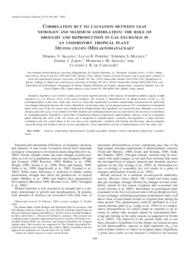Correlation but no causation between leaf nitrogen and maximum assimilation: the role of drought and reproduction in gas exchange in an understory tropical plant Miconia ciliata (Melastomataceae).
Correlation but no causation between leaf nitrogen and maximum assimilation: the role of drought and reproduction in gas exchange in an understory tropical plant Miconia ciliata (Melastomataceae).
Autoria: ARAGÃO, D. V.; FORTINI, L. B.; MULKEY, S. S.; ZARIN, D. J.; ARAUJO, M. M.; CARVALHO, C. J. R. de
Resumo: Alternative hypotheses were tested to explain a previously reported anomaly in the response of leaf photosynthetic capacity at light saturation (A..) in Miconia ciliata to dry-season irrigation. The anomaly is characterized by an abrupt increase in leaf A._ for nonirrigated plants at the onset of the rainy season to values that significantly exceeded corresponding measurements for plants that were irrigated during the previous dry season. Hypothesis I posits that a pulse in leaf nitrogen increases CO2 assimilation in nonirrigated plants at the onset of the wet season and is dampened for irrigated plants; this hypothesis was rejected because, although a wet-season nitrogen pulse did occur, it was identical for both irrigated and nonirrigated plants and was preceded by the increase in assimilation by nonirrigated plants. Hypothesis 2 posits that a reproduction-related, compensatory photosynthetic response occurs in nonirrigated plants following the onset of the wet season and is dampened in irrigated plants; consistent with hypothesis 2, high maximum assimilation rates for control plants in the wet season were significantly correlated with fruiting and flowering, whereas irrigation caused flowering and fruiting in the dry season, spreading M. ciliata reproductive activity in irrigated plants across the entire year.
Ano de publicação: 2005
Tipo de publicação: Artigo de periódico
Unidade: Embrapa Amazônia Oriental
Observações
1 - Por padrão são exibidas publicações dos últimos 20 anos. Para encontrar publicações mais antigas, configure o filtro ano de publicação, colocando o ano a partir do qual você deseja encontrar publicações. O filtro está na coluna da esquerda na busca acima.
2 - Para ler algumas publicações da Embrapa (apenas as que estão em formato ePub), é necessário ter, no celular ou computador, um desses softwares gratuitos. Sistemas Android: Google Play Livros; IOS: iBooks; Windows e Linux: software Calibre.
Acesse outras publicações
Acesse a Base de Dados da Pesquisa Agropecuária (BDPA) para consultar o acervo completo das bibliotecas da Embrapa.

